If you were expecting some kind of sun sign nonsense, forget about it. This is real astrology for the real world. If it's real astrology for yourself that you want, you can get it by phone or in print. And if you need help deciphering the astrological glyphs in the graphics accompanying this article, see Astroglyphs: Astrological Symbols Guide. Please note: this forecast is expressed in terms of Universal Time (UT).
If you do not think about your future, you cannot have one.
-- John Galsworthy
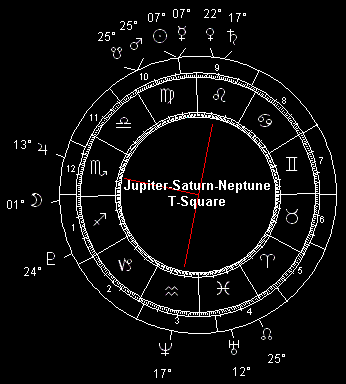 The historic celestial configurations of 2006 expand into 2007, combining with additional significant cycles and alignments out in space to churn out an amalgam that affords us little time to catch our breath, figuratively speaking. The arc of civilization has turned, humanity has altered course: it has begun. The changes in momentum and direction are relatively subtle and small at first, just as they were at this point in the similar cycle in the year 536. But they'll accelerate with each passing moment of 2007.
The historic celestial configurations of 2006 expand into 2007, combining with additional significant cycles and alignments out in space to churn out an amalgam that affords us little time to catch our breath, figuratively speaking. The arc of civilization has turned, humanity has altered course: it has begun. The changes in momentum and direction are relatively subtle and small at first, just as they were at this point in the similar cycle in the year 536. But they'll accelerate with each passing moment of 2007.
Well into 2007, Saturn and Neptune remain in the same on-and-off opposition that formed the foundation of last year's T-square. It's a pattern that looks like its namesake: two planets (Saturn and Neptune, in this case) at opposite ends of the heavens, with a third planet (Jupiter, this time around) at right angles (90°) to the other two. The 2006 T-square was the first such pattern formed between these two planets in Leo and Aquarius (respectively) and Jupiter in Scorpio since the one in the year 536. (There have been other Jupiter-Saturn-Neptune T-squares since, but none in this particular sign combination.)
Jupiter has now moved on from the T-square and into another significant arc - more on that in a moment - but Saturn and Neptune remain within a few degrees of precise opposition alignment throughout much of 2007. Due to retrogrades - apparent reverse motion in the sky, a function of the orbital dynamics of Earth and the other planets - Saturn and Neptune actually repeat their August 31, 2006 exact opposition twice in 2007, on February 28 and June 25. Exact dates of alignment aside, this is part of an ongoing celestial cycle that unfolds throughout 2007 - and for some years to come. At its most fundamental level, it's an alignment that points to a time when people, both individually and collectively, are experiencing a crisis of confidence. What was once apparently so solid and real that you could build a life, a financial system, a global trade network, even a civilization on it: that's just what has been dissolving under the aegis of Saturn's opposition to Neptune in combination with the T-square from Jupiter.
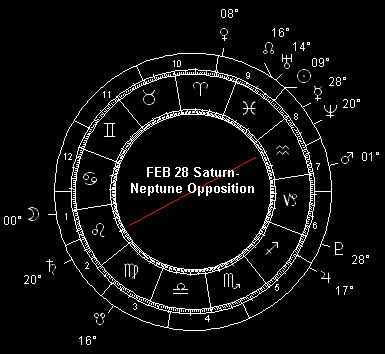 Consider the US dollar as a case in point. Since the Bretton Woods Agreement of the 1940s, which followed the 1940-1941 triple Jupiter-Saturn conjunction in Taurus, the dollar has been the foundation of the world financial and trade system. The dollar's recent sharp decline under the aegis of the Jupiter-Saturn-Neptune T-square - and the concomitant rise in the dollar-denominated price of commodities like gold and copper and oil - reflects a growing loss of confidence in the old order. By the same token, the declining relative strength of the dollar to other currencies is echoed in the declining importance of the US economy as a part of global economic activity. This is no mere blip in the signal: it's a turning point in civilization. The American Century is past. And that's not even the half of it, a topic to which I'll return a bit later. But there's more.
Consider the US dollar as a case in point. Since the Bretton Woods Agreement of the 1940s, which followed the 1940-1941 triple Jupiter-Saturn conjunction in Taurus, the dollar has been the foundation of the world financial and trade system. The dollar's recent sharp decline under the aegis of the Jupiter-Saturn-Neptune T-square - and the concomitant rise in the dollar-denominated price of commodities like gold and copper and oil - reflects a growing loss of confidence in the old order. By the same token, the declining relative strength of the dollar to other currencies is echoed in the declining importance of the US economy as a part of global economic activity. This is no mere blip in the signal: it's a turning point in civilization. The American Century is past. And that's not even the half of it, a topic to which I'll return a bit later. But there's more.
I mentioned that Jupiter has moved on from the T-square to Saturn and Neptune, to form another important arc in 2007; namely its quadrature (90° angle, the square aspect of astrological tradition) to Uranus. More precisely, this is a waning (sinister) square, a 270° arc. It's still a 90° separation measured the shortest way. But from the faster moving planet to the slower, it's an arc of 270°; i.e. it's three-fourths of the way through the (synodic) cycle from one conjunction to the next. In the over-all cycle between these two planets, the 2007 waning square is the last quadrature before the triple conjunction at the Pisces-Aries cusp of 2010-2011, which starts a new Jupiter-Uranus synodic cycle. This year's quadrature is also a triplet, with partile (exact) squares forming on January 22, May 11 and October 9. Together, this set comprises the first Sagittarius-Pisces square between Jupiter and Uranus respectively since the triplet of 1924. Both Sagittarius-Pisces triplets represent the three-quarters point of cycles that began with a Jupiter-Uranus conjunction in Aquarius; in 1914 and 1997 respectively.
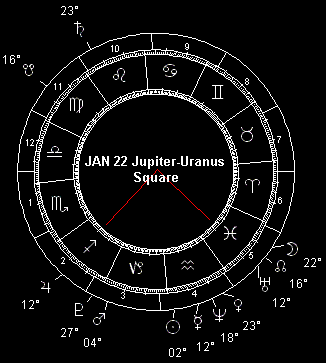 Jupiter-Uranus squares herald a point in time when an original intellectual/cultural impulse (an idea, whether individual or collective) comes to a point where significant revisions are necessary to keep it alive. Sometimes this entails a scheme that's too clever by half starting to go off the tracks. Typically, the origin of the impulse in question can be traced back to a time when Jupiter and Uranus were conjunct in the sky: think Prometheus stealing fire from the gods and bringing it to humanity. Sometimes a minor adjustment is all it takes to put things right at the turning point represented by the square of these two planets. Sometimes that's nowhere near enough.
Jupiter-Uranus squares herald a point in time when an original intellectual/cultural impulse (an idea, whether individual or collective) comes to a point where significant revisions are necessary to keep it alive. Sometimes this entails a scheme that's too clever by half starting to go off the tracks. Typically, the origin of the impulse in question can be traced back to a time when Jupiter and Uranus were conjunct in the sky: think Prometheus stealing fire from the gods and bringing it to humanity. Sometimes a minor adjustment is all it takes to put things right at the turning point represented by the square of these two planets. Sometimes that's nowhere near enough.
The last Jupiter-Uranus conjunction (1997, at 6° Aquarius) was the start of the dot-com bubble, which came crashing down in 2000 when Jupiter (then conjunct Saturn in Taurus) squared Uranus in Aquarius out in space. The 1997 alignment saw an Asian financial crisis (triggered by the collapse of the Thai currency, the bhat), and the US Federal Reserve under Alan Greenspan trying to derail the runaway train of "irrational exuberance". Chairman Greenspan failed, and the dot-com crash ensued at the first subsequent Jupiter-Uranus square. Speaking of the dot-com craze and Fed intervention, 1998 - when Neptune began its current sojourn in Aquarius, where it's opposed by Saturn twice this year - evidenced plenty of both, what with the Nasdaq index first crossing the 2,000 threshold, the Russian ruble collapse and debt default, the continuation of the Asian bust that began in '97, the Fed-engineered rescue of Long Term Capital Management (the hedge fund which collapsed and very nearly dragged the world's financial system down with it), etc. I think you get the picture.
The 1914 Jupiter-Uranus conjunction in Aquarius (10°) saw the US Federal Reserve begin operation, incidentally. In 1924, the last time there was a triple Jupiter-Uranus square in Sagittarius and Pisces like this year's, the Fed instituted what was then a new policy of investing in short-term government securities; both as a prudent fiscal measure in its own right, and as a measure for steering (controlling) the financial markets.
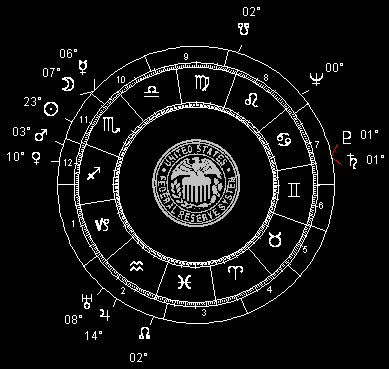 The Sagittarius-Pisces Jupiter-Uranus waning square of 1924 also heralded the death of Vladimir Lenin, a critical turning point in the political and cultural experiment that erupted in Russia with the 1917 Bolshevik Revolution; which in turn took place within months of the Taurus-Aquarius waxing square of Jupiter and Uranus. And of course the inspiration for that was Karl Marx's Communist Manifesto - written in 1847 and published in 1848, under the aegis of the 1847-1848 waxing squares of Jupiter and Uranus in Cancer and Aries respectively.
The Sagittarius-Pisces Jupiter-Uranus waning square of 1924 also heralded the death of Vladimir Lenin, a critical turning point in the political and cultural experiment that erupted in Russia with the 1917 Bolshevik Revolution; which in turn took place within months of the Taurus-Aquarius waxing square of Jupiter and Uranus. And of course the inspiration for that was Karl Marx's Communist Manifesto - written in 1847 and published in 1848, under the aegis of the 1847-1848 waxing squares of Jupiter and Uranus in Cancer and Aries respectively.
The same year (1924) that took Lenin out also brought an end to the Ottoman Empire, with Kemal Ataturk's abolition of the caliphate - a turn from a theocracy to a secular state. It was an empire that dated back to around the time of the 1292 Jupiter-Uranus conjunction in Leo; although the Ottoman Empire in turn had grown out of the Seljuk Turk Empire established in Asia Minor in 1071, under the aegis of a Jupiter-Uranus conjunction in Capricorn.
Some historical themes seem to keep cropping up in all these cyclical turning points in time: a massive financial crisis threatens the collapse of the economic order, and a socio-cultural-political revolution reaches a turning point where ideology gets sacrificed in order to facilitate a consolidation of power.
I'm not saying that the Jupiter-Uranus square of 2007 means a market crash, let alone a global financial meltdown. The total picture is always different, even when some details are the same. This time around, Jupiter and Uranus are in a waning quadrature (270° arc), not a waxing one (90° arc) as in the case of the 2000 dot-com crash. And the sign relationships are different as well: this time, Jupiter is in Sagittarius and Uranus is in Pisces, as opposed to the respective Taurus-Aquarius placements in 2000. Still, by late December of 2006, the Thai bhat was in trouble again; as was the dollar, which some central banks are now replacing with the euro. However the euro is essentially dollar-backed itself; and the dollar is only a shadow of its former stature. Which makes the world financial system a house of cards - and that's just the kind of structure that's critically vulnerable under the aegis of a Saturn-Neptune opposition coupled with a Jupiter-Uranus square. That's 2007 in a nutshell.
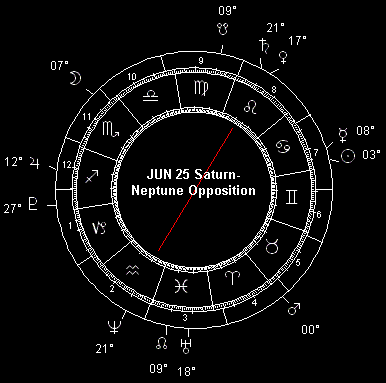 What would a New World Order look like, financially speaking? Assets in the domestic US market would appreciate in dollar terms, but the dollar would depreciate relative to other currencies. Commodities - e.g. metals (not just gold and silver) and energy resources like oil, gas and coal - would appreciate against all currencies, but especially against decliners like the dollar. Eventually, a move toward commodity-backed currencies is in the offing. But not this year. This year we're still in something akin to a bubble-bursting phase.
What would a New World Order look like, financially speaking? Assets in the domestic US market would appreciate in dollar terms, but the dollar would depreciate relative to other currencies. Commodities - e.g. metals (not just gold and silver) and energy resources like oil, gas and coal - would appreciate against all currencies, but especially against decliners like the dollar. Eventually, a move toward commodity-backed currencies is in the offing. But not this year. This year we're still in something akin to a bubble-bursting phase.
Think of the infamous Mississippi Bubble, which coincided with the 1719-1720 Saturn-Neptune opposition, the same alignment that beams down from the heavens for 2006-2007. The difference, I believe, is that this will be more like a soufflé settling than a bubble bursting. It doesn't go pop all at once, but in fits and starts over a period of years. If I'm right, it's already begun. And there will be some big and noticeable fits and starts in 2007 - probably in January, May and October (the Jupiter-Uranus square), as well as February and June (the Saturn-Neptune oppositions). In other words, on-and-off all year here and there around the world . . . currency crises, bank runs, bankruptcies personal and corporate and perhaps even national. But no total collapse. Something less, something manageable - like the Long Term Capital implosion, or the dot-com disaster. That's not to make light of the pain and suffering such events can cause individuals who get caught in their path. Stay alert, try not to be one of them.
I don't know that it matters much what starts a crisis of confidence stampede akin to the "Asian Contagion" or ruble collapse of 1997-1998 or the 2000 dot-com bust. Looking at the biennial Mars perigee (close approach to Earth) coming up this year, it's easy to imagine that a military conflict, terrorist attack or even some very awful accident or 'act of God' could be the trigger. Prominent Mars years, when Earth and Mars are relatively near each other, come once every two years, give or take a month or so. They correspond to the Sun-Mars opposition, which occurred in 2001 (a few months before the 9/11 attack) and in 2003 (as the insurgency phase got underway in Gulf War II). For 2007, the Mars perigee effect is active from the time Mars goes retrograde (November 15), peaking at the Sun-Mars opposition (December 24) and continuing through the end of the Red Planet's retrograde (January 30, 2008). That whole period is one of elevated tension and conflict, the kind of atmosphere that cultivates inflamed passions, hot tempers and rash, even violent action. Apart from the direct impact of the fires, clashes, crashes and explosions that are par for the course under this sort of Mars close pass, some such incidents can raise the possibility of a disruption in the oil and natural gas supply chain - which in turn can shock the financial markets and put investors and institutions in a mad dash for the exits.
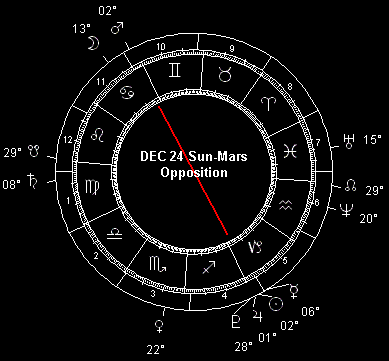 The 2007 Mars perigee is long lasting enough to hold sway over all of planet Earth. But its peak at the December 24 Sun-Mars opposition has an astro-locality profile that points to southern California as anchor of one longitudinal (north-south) zone of special vulnerability, mirrored by another longitudinal zone along the Iran-Pakistan-Afghanistan interface; as well as a horizon line that arcs through Anchorage, Alaska across northern Canada and then around to world to cross from south-central Australia up through Port Moresby, New Guinea. In any case, in every place, tensions are tweaked as Mars draws near the Earth in late 2007. Criminality, terrorism, military conflict: the year will not end on a quiet and peaceful note. But it's not the end of the world either: these bloody Mars cycles come up every couple of years, so we've survived plenty of them to date. Anyone born with significant horoscopic factors around three degrees of the cardinal signs - particularly in the Cancer-Capricorn axis where the Sun-Mars opposition takes place - might want to be extra safety-minded in December, just to be on the safe side. (Check your chart!)
The 2007 Mars perigee is long lasting enough to hold sway over all of planet Earth. But its peak at the December 24 Sun-Mars opposition has an astro-locality profile that points to southern California as anchor of one longitudinal (north-south) zone of special vulnerability, mirrored by another longitudinal zone along the Iran-Pakistan-Afghanistan interface; as well as a horizon line that arcs through Anchorage, Alaska across northern Canada and then around to world to cross from south-central Australia up through Port Moresby, New Guinea. In any case, in every place, tensions are tweaked as Mars draws near the Earth in late 2007. Criminality, terrorism, military conflict: the year will not end on a quiet and peaceful note. But it's not the end of the world either: these bloody Mars cycles come up every couple of years, so we've survived plenty of them to date. Anyone born with significant horoscopic factors around three degrees of the cardinal signs - particularly in the Cancer-Capricorn axis where the Sun-Mars opposition takes place - might want to be extra safety-minded in December, just to be on the safe side. (Check your chart!)
The December perigee point is probably the pinnacle of Red Planet presence this year, but it's hardly the only notable peak. Others come around March 21, 22 and 25 (Mars respectively passes over the degree of the February 7, 2008 solar eclipse, opposes Saturn and then aligns with Neptune), April 12, 25 and 29 (Mars passing over the August 28, 2007 and September 7, 2006 lunar eclipse points and conjoining Uranus respectively); plus August 23 (the Red Planet opposition to Jupiter), September 21 (the Mars-Pluto opposition) and November 15 (Mars' retrograde station point). Given the Red Planet's nominal rate of apparent motion, and the fact that some of the aforementioned phenomena blend into other notable activators, all the dates given here are in reality only the focal points of a window in time extending about a week either way. So put on your hard hat, your Kevlar vest and your iron gloves ahead of time; and keep your guard up, your fire extinguisher handy, etc. Think I'm kidding? Follow the news around these dates, and you'll see that the headlines only echo what I've written here. Firefights, crashes, explosions and other violent incidents tend to frequent Mars activations like these . . . major adrenaline rush, the heyday of heroes as well as the villains they struggle with. It's the "two men enter, one man leaves" arena of consciousness.
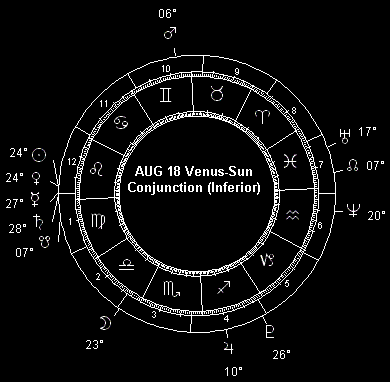 One saving grace this year, at least partially as far as national economies and the world financial structure are concerned, is the Venus intersolar cycle. It begins with Venus as evening star (Venus Vesper) reaching its maximum eastern elongation on June 9, and ends with Venus the morning star (Venus Lucifer) attaining its greatest western elongation on October 28. This is the time, once every year and a half or so, when Venus comes up from behind Earth on the inside orbital track, catches up on our home planet and then passes between us and the Sun before leaving us behind. I have come to call this the intersolar portion of Venus' cycle, because it's when Venus is on the same side of the Sun as Earth. Included within this part of the Venus intersolar cycle for 2007 are the July 27-September 8 retrograde (the latter date falling perilously close to the solar eclipse on the 11th), as well as Venus' inferior conjunction with the Sun on August 18 (which is conjunct Saturn - not a good sign).
One saving grace this year, at least partially as far as national economies and the world financial structure are concerned, is the Venus intersolar cycle. It begins with Venus as evening star (Venus Vesper) reaching its maximum eastern elongation on June 9, and ends with Venus the morning star (Venus Lucifer) attaining its greatest western elongation on October 28. This is the time, once every year and a half or so, when Venus comes up from behind Earth on the inside orbital track, catches up on our home planet and then passes between us and the Sun before leaving us behind. I have come to call this the intersolar portion of Venus' cycle, because it's when Venus is on the same side of the Sun as Earth. Included within this part of the Venus intersolar cycle for 2007 are the July 27-September 8 retrograde (the latter date falling perilously close to the solar eclipse on the 11th), as well as Venus' inferior conjunction with the Sun on August 18 (which is conjunct Saturn - not a good sign).
Most people are well aware of Mercury's retrograde, but not much attention is given to the retrogrades of other planets. Like Mercury, Venus is an inferior (i.e. inner) planet; which is to say that its orbit lies between Earth and Sun. When an inner planet in its faster orbit starts catching up on the slower orbiting Earth, the inner planet's apparent motion in our night sky begins to slow. It moves slower and slower until it comes to an apparent standstill in the heavens. This is the retrograde station, the point at which the planet appears to stop and then begin moving backwards (clockwise, or westward) through the sky. This period of reverse motion continues for some weeks (roughly three weeks for Mercury, about seven weeks for Venus), until the planet once again slows its nightly progress through the sky and again comes to an apparent standstill - the direct station, in this case. Normal counterclockwise (eastward) motion then resumes, until the next intersolar cycle brings a new retrograde.
 Now that you've got the picture - see the section on Mercury for an illustration of a typical intersolar cycle, if a thousand words is the long way 'round for you - one thing should be clear: during its intersolar cycle, an inferior planet is actually closer to Earth, brighter and more prominent in our sky. In the case of Venus, this tends to coincide with a period of relative ease and prosperity, all else being equal. All else is not equal during this year's Venus intersolar cycle, unfortunately. It starts in the same sign as, and within a few weeks of, Saturn's location at its final opposition to Neptune of the year; at a time when these two planets are barely more than a degree away from their exact alignment in the sky. And then there's the aforementioned proximity of Venus' conjunction with the Sun to the September 11 solar eclipse conjunct Saturn.
Now that you've got the picture - see the section on Mercury for an illustration of a typical intersolar cycle, if a thousand words is the long way 'round for you - one thing should be clear: during its intersolar cycle, an inferior planet is actually closer to Earth, brighter and more prominent in our sky. In the case of Venus, this tends to coincide with a period of relative ease and prosperity, all else being equal. All else is not equal during this year's Venus intersolar cycle, unfortunately. It starts in the same sign as, and within a few weeks of, Saturn's location at its final opposition to Neptune of the year; at a time when these two planets are barely more than a degree away from their exact alignment in the sky. And then there's the aforementioned proximity of Venus' conjunction with the Sun to the September 11 solar eclipse conjunct Saturn.
All this Saturn stuff in combination with Venus tends to weaken an otherwise favorable indicator, turning apparent prosperity into something considerably less. Consequently, I'm inclined to expect a generally lukewarm global economy at best this year. It's as if a promising start loses momentum, possibly by late spring and certainly by late summer. I expect it will be one of those situations where central banks manage to put together rescue and stimulus packages that keep things from falling to pieces - but only just barely.
Longer term celestial configurations are a shifting picture from year to year, like patterns in a cosmic kaleidoscope. Against this ever-changing backdrop, there are always some familiar annual motifs - although these too differ in detail from year to year, reflecting a blend of evolving cycles. Among these regularly recurring themes are solar and lunar eclipses and SuperMoon alignments.
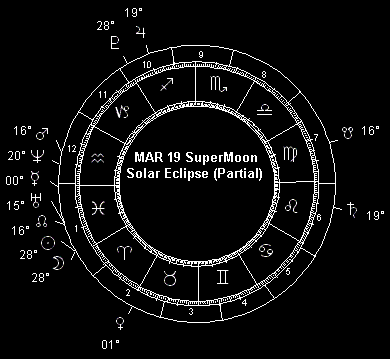 SuperMoon is a term I coined in a 1979 article for Dell Publishing Company's HOROSCOPE magazine, describing what is technically called a perigee-syzygy; a new or full moon (syzygy) which occurs with the Moon at or near (within 90% of) its closest approach to Earth in a given orbit. In short, Earth, Moon and Sun are all in a line, with Moon in its nearest approach to Earth. Like eclipses, there are typically four or five SuperMoons each year. Some years get a real bumper crop, and 2007 is one. There are six in all, this time around. These include a trio of new moons in the spring: a SuperMoon solar eclipse at the cusp of the vernal equinox on March 19 (28° 7' Pisces), followed by one on April 17 at 27° 5' Aries and a third new moon on May 16 at 25° 33' Taurus. Another trio follows in the fall, this time all full moons: one on September 26 at 3° 20' Aries, another on October 26 at 2° 24' Taurus, and the third and final SuperMoon of the year on November 24 at 1° 55'Gemini.
SuperMoon is a term I coined in a 1979 article for Dell Publishing Company's HOROSCOPE magazine, describing what is technically called a perigee-syzygy; a new or full moon (syzygy) which occurs with the Moon at or near (within 90% of) its closest approach to Earth in a given orbit. In short, Earth, Moon and Sun are all in a line, with Moon in its nearest approach to Earth. Like eclipses, there are typically four or five SuperMoons each year. Some years get a real bumper crop, and 2007 is one. There are six in all, this time around. These include a trio of new moons in the spring: a SuperMoon solar eclipse at the cusp of the vernal equinox on March 19 (28° 7' Pisces), followed by one on April 17 at 27° 5' Aries and a third new moon on May 16 at 25° 33' Taurus. Another trio follows in the fall, this time all full moons: one on September 26 at 3° 20' Aries, another on October 26 at 2° 24' Taurus, and the third and final SuperMoon of the year on November 24 at 1° 55'Gemini.
SuperMoons are noteworthy for their close association with extreme tidal forces working in what astrologers of old used to call the sublunary world; which is to say, in the atmosphere, crust and oceans of our home planet - including ourselves, of course. From extreme coastal tides to severe storms to powerful earthquakes and volcanic eruptions, the entire natural world surges and spasms under the sway of the SuperMoon alignment - within three days either way of the exact syzygy, is the rule of thumb.
If you're interested in the history of SuperMoon alignments in connection with great storms, earthquakes and volcanic eruptions, you'll find a sampling of them in my book Interpreting Astrology (published by the American Federation of Astrologers). But a simple review of the news over the past few years should serve to get you acquainted. Take Hurricane Katrina, for example; spawned from a tropical depression formed within three days of the August 19 SuperMoon. My forecast for 2005 warned of severe storms within plus or minus three days of the day Hurricane Katrina formed, and even specified the Gulf of Mexico as one of the areas at risk in connection with that particular SuperMoon alignment. I've done this for nearly thirty years now, from articles in the astrology press to the online forecasts at my website, Astropro.
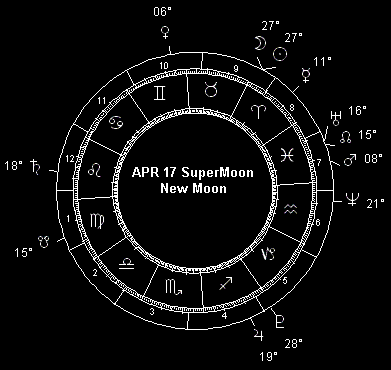 Obviously it won't be the case that all hell will break loose all over the world within a few days either side of the SuperMoons of 2007 - or the similarly potent eclipses either, which I'll cover in a moment. For most of us, the geocosmic risk raised by SuperMoon alignments will pass with little notice in our immediate vicinity. That said, anyone who is in a seismically active area, or along the coast, or in any place subject to severe weather - and let's face it, that can be just about anywhere - could do a lot worse than be prepared within plus or minus three days of the SuperMoons of 2007. What's the worst that can happen, if the worst doesn't happen? So you've got a few extra fresh batteries and candles, some extra bottled water and canned goods, maybe a full tank of gas and an evacuation bag packed just in case. And maybe you'll think twice about being in transit and more than usually vulnerable to the vagaries of weather hazards and delays. These may amount to only minor inconveniences. But they're the kind of sensible precautions that can make a big difference if the worst does come to pass. I can only call the dates. You have to make the call for yourself.
Obviously it won't be the case that all hell will break loose all over the world within a few days either side of the SuperMoons of 2007 - or the similarly potent eclipses either, which I'll cover in a moment. For most of us, the geocosmic risk raised by SuperMoon alignments will pass with little notice in our immediate vicinity. That said, anyone who is in a seismically active area, or along the coast, or in any place subject to severe weather - and let's face it, that can be just about anywhere - could do a lot worse than be prepared within plus or minus three days of the SuperMoons of 2007. What's the worst that can happen, if the worst doesn't happen? So you've got a few extra fresh batteries and candles, some extra bottled water and canned goods, maybe a full tank of gas and an evacuation bag packed just in case. And maybe you'll think twice about being in transit and more than usually vulnerable to the vagaries of weather hazards and delays. These may amount to only minor inconveniences. But they're the kind of sensible precautions that can make a big difference if the worst does come to pass. I can only call the dates. You have to make the call for yourself.
A SuperMoon is planetary in scale, being a special alignment of Earth, Sun and Moon. It's likewise planetary in scope, in the sense that there's no place on Earth not subject to the tidal force of the perigee-syzygy. Of course, earthquakes and volcanic eruptions don't go wandering the planet. They happen in predictable locations, like the infamous "Ring of Fire" around the Pacific plate. In short, if you're in (or plan to be in) a place that's subject to seismic upheaval during a SuperMoon stress window, it's not hard to figure out that being prepared to the extent that you can is not a bad idea. Likewise, people on the coast should be prepared for extreme tidal surges. Severe storms on the other hand can strike just about anywhere, so it behooves us all to be ready for rough weather when a SuperMoon alignment forms.
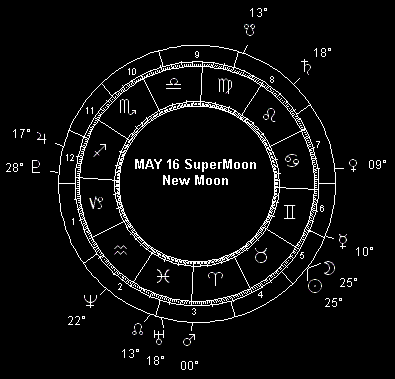 The planetary scope notwithstanding, astro-mapping may offer some hints as to areas of special vulnerability for each individual SuperMoon alignment. The SuperMoon solar eclipse of March 19, for example, shows astro-locality links to British Columbia, eastern Brazil, the Middle East, and along a longitudinal line from Tokyo down through Australia. The April 17 SuperMoon astro-map shows some indications of focusing on the Aleutian Islands, and along an arc that sweeps down from Canada through the US Plains States and Midwest, bracketing Dallas and New Orleans and then arcing across southern Mexico and the tip of South America. That same arc comes up on the other side of the world to pass through Indochina, central China and Mongolia, on its way out across Siberia. There's also a longitudinal band from the east coast of Norway down through France and west central Africa in this particular astro-map.
The planetary scope notwithstanding, astro-mapping may offer some hints as to areas of special vulnerability for each individual SuperMoon alignment. The SuperMoon solar eclipse of March 19, for example, shows astro-locality links to British Columbia, eastern Brazil, the Middle East, and along a longitudinal line from Tokyo down through Australia. The April 17 SuperMoon astro-map shows some indications of focusing on the Aleutian Islands, and along an arc that sweeps down from Canada through the US Plains States and Midwest, bracketing Dallas and New Orleans and then arcing across southern Mexico and the tip of South America. That same arc comes up on the other side of the world to pass through Indochina, central China and Mongolia, on its way out across Siberia. There's also a longitudinal band from the east coast of Norway down through France and west central Africa in this particular astro-map.
For the May 16 SuperMoon, astro-mapping shows a sensitive zone running longitudinally from Edmonton, Alberta down through the Baja Peninsula. On the other side of the world, that same line goes from Russia down through Afghanistan and Pakistan, while a horizon arc sweeps from the northwest coast of Africa through Western Europe and down through Siberia across Japan into the South Pacific and over New Zealand. The September 26 SuperMoon astro-map shows a longitudinal risk zone centered on Los Angeles in the western hemisphere and the along the Iran-Afghanistan border in the east, with horizon arcs sweeping from Greenland down across the coast of Brazil, and from Siberia down through New Guinea and eastern Australia.
Astro-mapping the October 26 SuperMoon shows a longitudinal risk zone from central Mongolia and China northward through Siberia and southward across Indochina and Indonesia. That same line shows up on the other side of the world to carve a swath through Ontario Province southward to bracket Washington DC and Raleigh, North Carolina; continuing across Cuba and Central America to the northern and northwestern tip of South America. This particular map also includes a horizon arc running northwesterly through Africa across the Mediterranean Sea and Eastern Europe across western Russian (including Moscow and Kiev). And last but not least is the November 24 SuperMoon astro-map, featuring a longitudinal zone of vulnerability from Rio de Janeiro in the New World to cross Tokyo in the Old, down through Indonesia and central Australia. This map also shows a suspicious looking horizon sweeping from southern California out across the Rockies and central Canada, across southern Greenland and Iceland and down through Eastern Europe, the Middle East and the Horn of Africa. I have only hit the highlights, as you can see by examining the maps for yourself. (The Mars lines could also be mentioned, for example.)
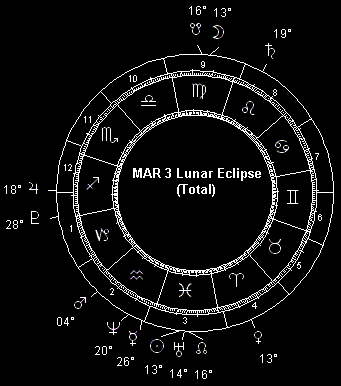 Much like SuperMoons in terms of their geophysical correlates are the eclipses. They too signal an upwelling of significant storms with high winds and heavy precipitation, along with moderate-to-severe seismic activity (including Richter 5 and higher earthquakes, as well as volcanic eruptions). Lunar eclipses like the ones on March 3 and August 28 tend to have the same plus or minus three day geocosmic stress window as a SuperMoon. Solar eclipses on the other hand point to a stress window that extends longer in time, as much as a week before and after the actual eclipse date. This applies in the case of the March 19 SuperMoon solar eclipse, as well as the September 11 solar eclipse.
Much like SuperMoons in terms of their geophysical correlates are the eclipses. They too signal an upwelling of significant storms with high winds and heavy precipitation, along with moderate-to-severe seismic activity (including Richter 5 and higher earthquakes, as well as volcanic eruptions). Lunar eclipses like the ones on March 3 and August 28 tend to have the same plus or minus three day geocosmic stress window as a SuperMoon. Solar eclipses on the other hand point to a stress window that extends longer in time, as much as a week before and after the actual eclipse date. This applies in the case of the March 19 SuperMoon solar eclipse, as well as the September 11 solar eclipse.
Both types of eclipses, like a SuperMoon, are planet-wide in scope. To the extent that localization cues can be discerned, a solar eclipse's zone of visibility is one clue. In the case of the March 19 SuperMoon solar eclipse, this includes all of Asia, from Iran eastwards; as well as parts of Alaska. For the September 11 solar eclipse, the zone of visibility is pretty well restricted to the southern three-fourths of South America, along with parts of Antarctica.
Astro-mapping zones of vulnerability can also be done for eclipses, as already illustrated with regard to the March 19 SuperMoon solar eclipse. Similarly, mapping out the March 3 total lunar eclipse shows signs of vulnerability along a horizon arc through Ontario, Canada and across the eastern US, out through Florida to cross Cuba and the west coast of South America. In the eastern hemisphere, that same arc cuts up through Indonesia, Indochina and eastern China. The longitudinal risk zones in this map touch the Aleutians and the west coast of Alaska (around Nome), coming down through Italy and Africa around Tripoli. West Africa and New Zealand are the only places under the longitudinal danger zone for the September 11 solar eclipse, but the astro-map for that event shows a risky looking horizon line through the Rockies from Canada down through Mexico, passing through India, western China and northeasterly on through Russia. Lastly, there's the astro-map for the August 28 lunar eclipse, which shows a longitudinal risk zone through Eastern Europe and Central Africa, coming up through Hawaii and Alaska on the other side of the world. Horizon arcs for this eclipse swing from Ontario down through Washington DC, Cuba, and a little west of central South America (including parts of Colombia, Venezuela, Western Brazil, Bolivia and Argentina); continuing around through Indonesia and eastern China (including Hong Kong and Beijing).
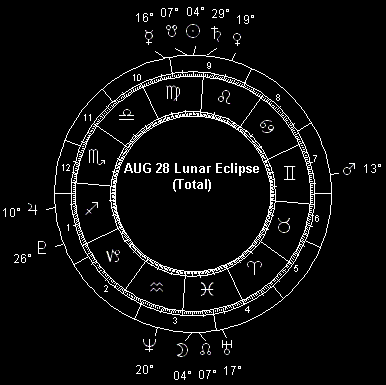 I should mention that this year's near-peak lunar declination extremes are a good indication that another world-class round of major seismic upsets and monster storms is likely in 2007. The lunar declination triggers detailed in my online table of these events for the year (each being active for 30-36 hours either side of the exact event) outline some of the most threatening geocosmic stress windows of 2007. Those in the spring and fall look particularly potent, given their close proximity in time to the SuperMoons and eclipses then. Be ready this year. If the authorities order an evacuation where you live, don't chance it - just hit the road. I have three clients who'd be alive today if they just followed that simple advice. Most of us won't need survival and evacuation kits and plans this year, but it's too late to put them together if you wait until the wind starts to blow or the ground starts to shake, or the evacuation order comes.
I should mention that this year's near-peak lunar declination extremes are a good indication that another world-class round of major seismic upsets and monster storms is likely in 2007. The lunar declination triggers detailed in my online table of these events for the year (each being active for 30-36 hours either side of the exact event) outline some of the most threatening geocosmic stress windows of 2007. Those in the spring and fall look particularly potent, given their close proximity in time to the SuperMoons and eclipses then. Be ready this year. If the authorities order an evacuation where you live, don't chance it - just hit the road. I have three clients who'd be alive today if they just followed that simple advice. Most of us won't need survival and evacuation kits and plans this year, but it's too late to put them together if you wait until the wind starts to blow or the ground starts to shake, or the evacuation order comes.
Review the great storms and earthquakes that have afflicted various parts of our planet from late 2004 through last year, as the Moon's declination attained its 18.6-year cyclical peak. From the Boxing Day 2004 tsunami to Hurricane Katrina and the Kashmir Quake of 2005 and the great Pacific typhoons of 2006, this extreme declination cycle has been accompanied by some of the worst natural upheaval in years. We're barely down from the peak of those past years in 2007, so it's only prudent to pay particular attention to the geophysical stress periods I've mentioned in connection with this year's SuperMoons and eclipses, as well as the 2007 declination extremes listed for the year in the table I have provided online.
While I have focused to this point on the geophysical realm, I'd be remiss if I didn't point out that the planetary environment that gets stirred up at SuperMoon and eclipse times includes our own psyches. All else being equal, many people tend to get over-emotional during a SuperMoon or eclipse window. Make allowances and adjustments for this, in yourself and in your interaction with others. Sometimes it's a good thing when emotions well up stronger than usual. Sometimes it's not. Knowing when it can happen just might be advantageous. A SuperMoon or eclipse is far from the only cosmic timing signal for this sort of emotional upwelling, of course. But it's a big and predictable one that's worth watching. And you know the dates to watch for . . .
 SuperMoons and eclipses are not the only celestial phenomena to turn up every year. Another familiar annual theme involves the cycles of Mercury. Being closest to the Sun, Mercury goes intersolar as seen from Earth more than any other planet; several times a year in fact, including the infamous Mercury retrogrades of astrological legend. While most astrologers pay a fair amount of attention to Mercury's retrograde, few realize that it's only a part of the more fundamental intersolar phase in the orbital interaction between Mercury and Earth, as they both orbit around the Sun.
SuperMoons and eclipses are not the only celestial phenomena to turn up every year. Another familiar annual theme involves the cycles of Mercury. Being closest to the Sun, Mercury goes intersolar as seen from Earth more than any other planet; several times a year in fact, including the infamous Mercury retrogrades of astrological legend. While most astrologers pay a fair amount of attention to Mercury's retrograde, few realize that it's only a part of the more fundamental intersolar phase in the orbital interaction between Mercury and Earth, as they both orbit around the Sun.
Mercury's intersolar phase begins when the little Sun-grazer reaches its maximum elongation east of the Sun - its evening star phase. This happens when Mercury has come 'round to the same side of the Sun as Planet Earth, and is relatively near us. The little planet is then pulling up to pass Earth on the inside track, as it were; catching up to us from behind and then passing between us and the Sun. Just as it catches up with us, Mercury passes directly between Earth and the Sun. This is Mercury's inferior conjunction with the Sun. After the inferior conjunction, Mercury continues pulling ahead of us until it reaches its greatest elongation west of the Sun (its morning star phase), at which point the little planet is headed toward the far side of our parent star. Between these two extremes, the greatest east and west elongations, comes the fabled Mercury retrograde period of astrological lore.
Retrograde means moving backwards, which is what Mercury appears to do in our skies when the little inner planet catches up on us and passes us on the inside, between Earth and the Sun. First Mercury reaches its greatest eastern elongation, then it appears to stand still in the sky (the retrograde station), and then it appears to move backwards through the heavens for a period of several weeks: that's Mercury retrograde for you. It ends when the little Sun-grazer's backwards motion comes to an apparent halt (the direct station); after which, Mercury moves forward again, until it reaches its maximum elongation west of the Sun. The reality of course is that Mercury never stops in its orbit, and never moves backward: this is only how the relative motions of Earth and Mercury around the Sun cause Mercury to move through our night sky. (See the animated illustration above.)
Mercury retrograde is the cycle when everything goes wrong, to hear some astrologers tell it. The truth is not so simple-minded. All things Mercurial are crucial during the intersolar Mercury phase; infrastructure, commerce, information, communication and transport being prime examples. Absent careful investigation and planning, and conscientious follow-through, all such things are apt to go off track during these cycles. There is "a time to every purpose under heaven," as the Preacher wrote (Ecclesiastes 3:1). Mercury's intersolar phase is a time for focus, concentration, planning, follow-through and communication - all the qualities of the active and involved mind, in short. In case you haven't noticed, most people are not especially alert and focused most of the time. When this kind of sleepwalking runs into Mercury's intersolar cycle, with its focus on mental acuity, it doesn't take long for things to go awry. If you're sharp and focused and alert, you can avoid a certain amount of this mess. In fact, you can even prosper by concentrating on tasks that center on thought, planning and communication. But you'll still have to dodge all the messes created by the people who are sleepwalking. So be ready.
Among the sort of things to be ready for during the above mentioned Mercury intersolar cycles: strikes and other disruptions affecting transportation and communication (e.g. postal, phone, mass transit, trucking, airline, shipping, dock and warehouse workers, teachers and all manner of media). Weather both terrestrial and solar (including geomagnetic storms) can play a part in the kind of breakdowns described here, but human effort (and sometimes malicious action) is a part of the mix as well. Power failures due to infrastructure breakdown and computer network disruptions caused by hacker attacks, software vulnerabilities and the like are also just a crossed wire or a keystroke away from a major mess at these times.
If I had to pick a day to have a backup generator all fueled up and ready to go, a backup plan in place in case the scheduled or expected didn't come to pass, a day to be especially sharp and steady and focused - it would be during one of these Mercury cycles. Note these dates; be ready with a fallback plan just in case. It's not so much that disaster is destined to strike when Mercury is in its intersolar phase. Rather, it's that everything pertaining to Mercury becomes crucial; and unless it's treated as such, then it goes awry. Unfortunately, few people keep their eye on the ball with any consistency and diligence. And that's the reason these Mercury cycles tend to turn into Murphy's Law festivals. Don't say I didn't warn you!
The first intersolar Mercury phase of 2007 begins with the little planet's maximum elongation eastward on February 7, includes the February 14-March 8 retrograde and the February 23 inferior conjunction with the Sun, and ends with Mercury's greatest western elongation on March 22. Next comes the June 2 greatest eastern elongation, initiating a Mercury intersolar cycle which includes the June 15-July 10 retrograde and the June 28 inferior conjunction, and concludes with the July 20 western elongation maximum. Finally this year there's the Mercury intersolar phase that starts with the maximum eastern elongation on September 29, includes the October 12-November 1 retrograde and the October 23 inferior conjunction, and wraps up with the western elongation extreme on November 8.
I'll close by returning to a topic mentioned in passing at the outset; namely that I see signs in the celestial configurations at work lately and into the near term future - basically starting in 1998 or 2000 at the latest, and continuing through about 2020 - that the American Century has passed into history. I think it's even more than that: the European Epoch is drawing to a close. There seems in some respects to be a dialectic to celestial cycles, such that each one ending gives birth to what is in some ways its polar opposite. Of course there are multiple cycles running concurrently at any time, so it's not easy to determine where one ends and another begins, or which has precedence over the rest.
Many of the planetary cycles described in this year's forecast deal with what amounts to an East-West clash of civilizations that dates back at least to the Greco-Persian wars of antiquity. The West arguably gained supremacy in that clash around the time that Pluto last aligned with the Galactic Center, at the start of the Industrial Revolution in the mid-18th Century. With Pluto once more aligning with the Galactic Center, off and on throughout 2007, I believe that one of those grand cycles of history is shifting once more. If I'm right, the signs of that New World Order are already visible, and will be growing inexorably as we move toward the next Great Chronocrator (Jupiter-Saturn conjunction), in 2020. Look back to the 536 T-Square with an historical consciousness, and it was clearly the peak of the Eastern Roman Empire - which, like the sun, once having reached its zenith, could only set. The great migrations, the climate change, the East-West clashes of that era are come once again, heralded by the same celestial configuration.
ACKNOWLEDGMENTS: All astrological charts as well as eclipse and astro-locality maps were calculated and produced using Matrix Software's WinStar Plus 2.05. Additional astronomical diagrams and calculations were produced with John Walker's HomePlanet 3.1 and Maris Technologies' RedShift 5 software. Fred Espenak's NASA Eclipse Home Page is an indispensable online reference.